1 of 12
Download to read offline
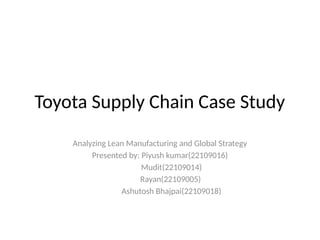


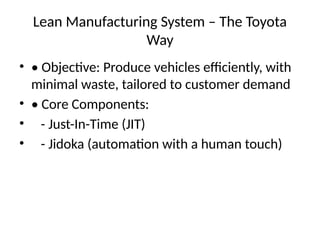
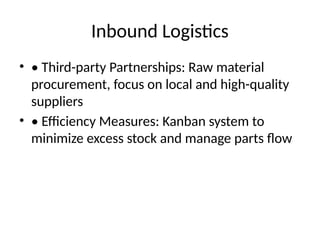
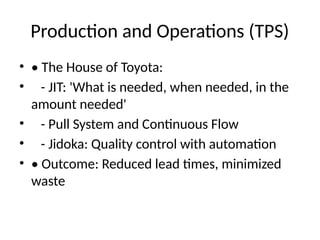
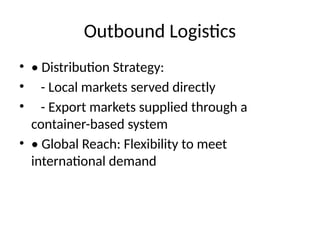
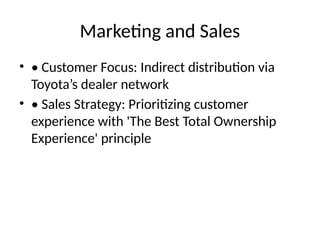

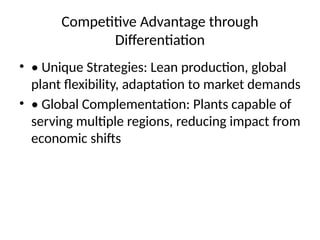

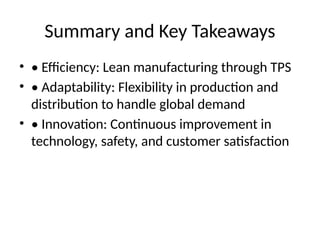
Ad
Recommended
Alok
AlokAlok Chaudhary
?
Toyota is a global auto manufacturer known for its Toyota Production System (TPS). TPS was developed to improve quality and productivity with the goal of producing vehicles as quickly and efficiently as possible to meet customer orders. TPS is based on two main concepts: just-in-time production and jidoka. Toyota works closely with suppliers and treats them as partners to efficiently manage its supply chain operations through strategies like clustering suppliers by location. This integrated approach has helped Toyota compete globally and maintain a stable supply network.TOYOTA ASSIGNMENT
TOYOTA ASSIGNMENTOmkarPatil272
?
Toyota was founded in 1937 and is headquartered in Toyota City, Japan. It is the world's largest automaker based on 2020 unit sales. Toyota follows a just-in-time production model and focuses on quality, cost, efficiency and safety. It partners with reliable tier 1 suppliers to deliver parts through an extensive logistics network to manufacturing plants. Vehicles are assembled and quality checked before being transported to dealerships for customers. After an earthquake disrupted its supply chain, Toyota took steps to standardize parts, increase inventory buffers, and regionalize procurement to build resilience against future disasters.Toyota Logistics
Toyota Logistics Samer Salameh
?
Toyota is a leading Japanese automotive manufacturer established in 1937, known for its production efficiency and innovation in lean manufacturing. The company operates under five brands and has a strong presence in global markets, targeting various customer segments and focusing on quality and dependability. Despite facing challenges like large-scale recalls, Toyota continues to expand its sales and operations in emerging markets with a reputation for environmentally friendly vehicles.Toyota
ToyotaSheikh Shahnawaz
?
Toyota is a global auto manufacturer known for its lean manufacturing system called the Toyota Production System (TPS). The objectives of TPS are to produce vehicles as quickly and efficiently as possible based on customer orders. Toyota uses a combination of local sourcing and imports from Japan for raw materials. It practices just-in-time production and continuous flow processing. Finished vehicles are sent directly from plants to Toyota dealers. Toyota has a global network of over 45 plants with flexibility to supply different markets and regions.Toyota Scm
Toyota ScmUday Patil
?
Toyota has an integrated supply chain management system to ensure the right product reaches the right customer at the right time. They organize suppliers into tiers and encourage cooperation. Toyota develops long-term relationships with suppliers and focuses on gradual improvement rather than price negotiations. They apply lean manufacturing principles and continuous improvement to produce high quality vehicles with low costs and short lead times. Toyota's distribution system involves multiple sales channels and dealerships to effectively market and sell vehicles worldwide.Toyota Supply chain Management
Toyota Supply chain Management Siddhi Suthar
?
Toyota has a global supply chain management system focused on lean manufacturing principles. They aim to produce only what is needed through just-in-time production and a pull system. Toyota designs their production system and supplier relationships to eliminate waste and variability. This includes designing parts for commonality, limiting optional variations, and sourcing locally for flexibility. Toyota audits suppliers using metrics focused on quality, cost, delivery and their implementation of Toyota's philosophies. Their logistics network transports parts through local and global inbound routes planned through optimization software.Toyota case study Virimayi Chinyama 2017 GZU exam Prep
Toyota case study Virimayi Chinyama 2017 GZU exam PrepVirimayi Chinyama
?
Toyota was founded in 1937 and struggled until adopting lean production methods in 1950 after studying Ford's Detroit plant. This new Toyota Production System helped dramatically improve the company's efficiency and quality. The cultural environment in postwar Japan emphasized lifetime employment and company-community relationships. Political policies protected domestic automakers while technological and demographic factors shaped Toyota's focus on diverse, tailored products. Toyota's lean strategies like just-in-time production and treating suppliers as partners led to advantages in reliability, variety, and responsiveness that helped them compete against larger Western firms.Toyota case study
Toyota case studyUsman Zafar
?
Toyota was founded in 1937 and struggled until adopting lean production methods in 1950 based on the Ford Rouge plant. This new Toyota Production System focused on eliminating waste and improving quality and efficiency. It emphasized continuous improvement, problem prevention, flexible labor, and just-in-time processes. Toyota also developed strong partnerships with suppliers and a network structure within the company to support reliable production of diverse vehicle models. These lean strategies led to increased productivity, quality, and responsiveness to market demands, giving Toyota competitive advantages over Western automakers.supply chain analysis with recommendations
supply chain analysis with recommendationsRahatulAshafeen
?
Toyota Motor Corporation, founded in 1937, is a leading global auto manufacturer known for pioneering just-in-time inventory and lean manufacturing principles to improve efficiency and quality. The company faces supply chain challenges such as natural disasters, economic downturns, and semiconductor shortages, prompting it to enhance risk management strategies and foster strong supplier partnerships. Key initiatives have included diversifying suppliers, adopting advanced technology, and maintaining flexibility to improve customer satisfaction and resilience in its supply chain.Toyota company presentation
Toyota company presentation ANJALI8005
?
Toyota Motor Corporation, founded in 1937 as an automotive manufacturer, originated from a textile company and has become the largest vehicle manufacturer in Japan. The company developed the Toyota Production System (TPS), emphasizing waste reduction, just-in-time production, and quality management, which has significantly influenced global automotive manufacturing practices. Toyota employs strategies like Jidoka and Kaizen in its operations, focusing on continuous improvement and efficiency while maintaining strong supplier relationships and localized manufacturing.Value chain ??and competitive advantage of pt toyota ppt (task)
Value chain ??and competitive advantage of pt toyota ppt (task)stmt trisakti
?
Toyota has developed an integrated lean manufacturing system called the Toyota Production System (TPS) to improve quality and productivity. TPS focuses on just-in-time production, continuous flow, and stopping production to fix problems. Toyota also focuses on cost leadership through lean supply chain management and reducing inventory levels. Other competitive advantages include their strong company culture developed around the Toyota Way principles, human resource practices, and segmentation of customers.toyotafinalpresentation1-190127071123.pdf
toyotafinalpresentation1-190127071123.pdfSumit133807
?
Toyota Motor Corporation is a Japanese automotive manufacturer founded in 1937. It employs over 364,000 people worldwide and has its headquarters in Toyota City, Japan. Toyota pioneered the Toyota Production System, including just-in-time manufacturing and continuous improvement. Toyota focuses on quality, efficiency and lean production to minimize costs and waste. It has manufacturing plants worldwide and uses a mix of global, regional and local strategies to address different markets.Toyota supply chain management
Toyota supply chain managementAbhinav Kp
?
The document outlines Toyota Motor Corporation's production system, known as the Toyota Production System (TPS), which focuses on lean manufacturing to improve efficiency and quality in vehicle production. Key elements include the Just-In-Time (JIT) approach and Jidoka, emphasizing the importance of timely production and the ability to halt operations for quality control. The supply chain involves local and imported parts through a structured logistics system designed to minimize waste and respond promptly to customer demand.Supply Chain Management of TOYOTA.......case study by sabio bernard.
Supply Chain Management of TOYOTA.......case study by sabio bernard.Sabio Bernard
?
Toyota is a global auto manufacturer known for its lean manufacturing system called the Toyota Production System (TPS). TPS was developed to improve quality and productivity with the goal of efficiently producing vehicles for customers. Toyota has a global strategy of opening factories in each market it serves and designing plants with flexibility to export to other markets when local demand weakens. For its supply chain, Toyota must address questions around plant location, capacity, market allocation, and product design flexibility to facilitate efficient global manufacturing and distribution.Case Study Of Toyota Motor Corporation ( Or Toyota )
Case Study Of Toyota Motor Corporation ( Or Toyota )Crystal Williams
?
Toyota Motor Corporation is a Japanese automaker and the world's largest manufacturer by production and sales. It employs over 300,000 people worldwide and produces vehicles under several brands, including Toyota, Lexus, and Scion. Toyota pioneered the Toyota Production System, also known as "Lean Manufacturing," which focuses on eliminating waste and improving efficiency. This system, along with high-quality vehicles, has made Toyota a leader in the automotive industry.Toyota
ToyotaJill Baldwin
?
The document discusses Toyota's production system and its key principles. It explains that Toyota views its operations as communities of scientists who test hypotheses through a scientific process. Rule 1 is that every job and action is specified in detail to reduce variations and errors. Toyota also encourages participation from all team members and stimulates continuous learning. The Toyota production system grew organically over decades focused on high quality, flexibility and waste reduction.Toyota
ToyotaSanjana Rajshekar
?
Toyota operates an integrated global supply chain with suppliers clustered near assembly plants and uses just-in-time production and logistics to efficiently deliver parts and finished vehicles. Key aspects of their supply chain include partnering with suppliers and dealers, level production to maintain stability, and effective demand forecasting to coordinate production and logistics. While Toyota's supply chain is efficient, further oversight of lower-tier suppliers is needed as the company expands globally.Toyota SCM
Toyota SCMAniruddh Tiwari
?
The document outlines Toyota's business model, which includes integrated low-cost and differentiated strategies for automobile design, manufacturing, and sales. It emphasizes a just-in-time inventory system, partnerships with reliable tier 1 suppliers, and efficient inbound and outbound logistics. Challenges include managing tier-2 and tier-3 suppliers, ensuring they align with Toyota's operational standards as the company expands.Automotive Industry & Toyota Scm
Automotive Industry & Toyota Scmpraveenvarghese
?
The document provides an extensive overview of the global automotive industry with a focus on Toyota's supply chain management principles and practices, particularly emphasizing the Toyota Production System (TPS) and the 'beer game' as a learning tool. It outlines key concepts such as quality assurance, just-in-time production, and operational processes aimed at achieving efficiency and minimizing waste within the supply chain. Additionally, the document highlights Toyota's commitment to sustainability and community engagement through its corporate philosophy and learning frameworks.Toyota
ToyotaVishwanath Shivashimpar
?
Toyota is a large Japanese automaker founded in 1937. It has global operations in over 170 countries and annual revenue of over $265 billion. Toyota employs over 369,000 people worldwide and is headquartered in Toyota City, Japan. The company pioneered the Toyota Production System, also known as lean manufacturing, which emphasizes eliminating waste. Toyota has a focus on just-in-time inventory management, continuous process improvement, and uses a pull-based production system. The document provides details on Toyota's operations management strategies, production layout, material handling, and inventory management approach.Km bs process
Km bs processGunjan Tiwari
?
This document discusses the Toyota Production System and its transition from mass production to lean manufacturing. It provides background on Toyota as the world's largest automaker. The key aspects of the Toyota Production System discussed are just-in-time production and supply chain integration, which aim to eliminate waste through continuous improvement. Suppliers are expected to provide frequent, small deliveries with high reliability and participate in long-term relationships focused on productivity and quality gains.Operation management, toyota production system
Operation management, toyota production systemOmar Hamdan
?
The document is an academic report by Omar S. Hamdan on Toyota's production system and operations management techniques, particularly focusing on lean manufacturing and just-in-time (JIT) inventory management. It outlines how Toyota's decentralized structure, commitment to continuous improvement, and unique production philosophies contribute to its competitive advantage in the automobile market. The report includes theoretical frameworks and practices like quality management, supply chain management, and team involvement, which collectively enhance efficiency and reduce waste in production.Toyota Case Study
Toyota Case StudyAngela Weber
?
Toyota faced a recall crisis due to quality issues with their vehicles. They experienced problems with accelerators becoming stuck and pedals obstructing. This led to customer accidents and lawsuits against Toyota. Toyota's management became too centralized and did not listen well to concerns from regional markets. As a result, Toyota was slow to respond to local problems. This violated Toyota's founding principles of empowering employees and continuous improvement.Presentation on toyota_motors[1]
Presentation on toyota_motors[1]harsimran25
?
Toyota Motors is the third largest automotive manufacturer in the world based on annual vehicle sales. Some key details:
- Toyota produces over 5.5 million vehicles per year across 56 manufacturing plants on 6 continents.
- It employs around 200,000 people worldwide and is headquartered in Toyota City, Japan.
- The Toyota Production System focuses on eliminating waste and improving efficiency through practices like just-in-time manufacturing and single-minute exchange of dies.
- This lean manufacturing approach helped Toyota become one of the most profitable automakers and the world's largest by 2007.Presentation on toyota_motors[1]
Presentation on toyota_motors[1]harsimran25
?
Toyota Motors is the third largest automotive manufacturer in the world based on annual vehicle sales. Some key details:
- Toyota produces over 5.5 million vehicles annually across 56 manufacturing plants on 6 continents.
- It employs around 200,000 people worldwide and is headquartered in Toyota City, Japan.
- The Toyota Production System focuses on eliminating waste and improving efficiency through practices like just-in-time manufacturing and single-minute exchange of dies.
- This lean manufacturing approach helped Toyota become one of the most profitable automakers and the world's largest by 2007.Toyota
Toyotamailshobhon
?
This document summarizes a Japan trip presentation about Toyota. It provides background on Toyota, including its establishment, production figures, manufacturing footprint, and use of the Toyota Production System. It then discusses current automotive industry trends like consolidation, a push into emerging markets, demand for smaller vehicles, environmental regulations, and the role of the internet. The presentation identifies challenges facing Toyota and its strategies to address them. It concludes with questions the presenters have for Toyota. Toyota Production System
Toyota Production SystemAmol Shah
?
Toyota Motor Corporation, founded in 1937 by Kiichiro Toyoda, focuses on the efficient production of automobiles using the Toyota Production System (TPS), which emphasizes quality control, waste reduction, and just-in-time manufacturing. The company's main objectives include eliminating overburden and waste while maintaining smooth production flow. As of the first half of 2007, Toyota became the world's largest car seller, with significant global market reach and ongoing operations in the textile industry.PRODUCTION AND MATERIAL MANAGEMENT
PRODUCTION AND MATERIAL MANAGEMENTAman Singh
?
Toyota Motor Corporation is a Japanese multinational automaker headquartered in Toyota, Aichi, Japan. The company was founded in 1937 by Kiichiro Toyoda as a spin-off from his father's company Toyota Industries to create automobiles. Toyota is considered one of the largest automakers in the world. It employs over 300,000 people worldwide and is known for its Toyota Production System which aims to eliminate waste and improve efficiency through just-in-time production and continuous improvement. The Toyota Production System utilizes approaches like total quality management, continuous flow production, pull signaling with kanban cards, and continuous improvement processes like kaizen to minimize waste and production variability.More Related Content
Similar to Toyota_Supply_Chain_Case_Study.pptx case (20)
supply chain analysis with recommendations
supply chain analysis with recommendationsRahatulAshafeen
?
Toyota Motor Corporation, founded in 1937, is a leading global auto manufacturer known for pioneering just-in-time inventory and lean manufacturing principles to improve efficiency and quality. The company faces supply chain challenges such as natural disasters, economic downturns, and semiconductor shortages, prompting it to enhance risk management strategies and foster strong supplier partnerships. Key initiatives have included diversifying suppliers, adopting advanced technology, and maintaining flexibility to improve customer satisfaction and resilience in its supply chain.Toyota company presentation
Toyota company presentation ANJALI8005
?
Toyota Motor Corporation, founded in 1937 as an automotive manufacturer, originated from a textile company and has become the largest vehicle manufacturer in Japan. The company developed the Toyota Production System (TPS), emphasizing waste reduction, just-in-time production, and quality management, which has significantly influenced global automotive manufacturing practices. Toyota employs strategies like Jidoka and Kaizen in its operations, focusing on continuous improvement and efficiency while maintaining strong supplier relationships and localized manufacturing.Value chain ??and competitive advantage of pt toyota ppt (task)
Value chain ??and competitive advantage of pt toyota ppt (task)stmt trisakti
?
Toyota has developed an integrated lean manufacturing system called the Toyota Production System (TPS) to improve quality and productivity. TPS focuses on just-in-time production, continuous flow, and stopping production to fix problems. Toyota also focuses on cost leadership through lean supply chain management and reducing inventory levels. Other competitive advantages include their strong company culture developed around the Toyota Way principles, human resource practices, and segmentation of customers.toyotafinalpresentation1-190127071123.pdf
toyotafinalpresentation1-190127071123.pdfSumit133807
?
Toyota Motor Corporation is a Japanese automotive manufacturer founded in 1937. It employs over 364,000 people worldwide and has its headquarters in Toyota City, Japan. Toyota pioneered the Toyota Production System, including just-in-time manufacturing and continuous improvement. Toyota focuses on quality, efficiency and lean production to minimize costs and waste. It has manufacturing plants worldwide and uses a mix of global, regional and local strategies to address different markets.Toyota supply chain management
Toyota supply chain managementAbhinav Kp
?
The document outlines Toyota Motor Corporation's production system, known as the Toyota Production System (TPS), which focuses on lean manufacturing to improve efficiency and quality in vehicle production. Key elements include the Just-In-Time (JIT) approach and Jidoka, emphasizing the importance of timely production and the ability to halt operations for quality control. The supply chain involves local and imported parts through a structured logistics system designed to minimize waste and respond promptly to customer demand.Supply Chain Management of TOYOTA.......case study by sabio bernard.
Supply Chain Management of TOYOTA.......case study by sabio bernard.Sabio Bernard
?
Toyota is a global auto manufacturer known for its lean manufacturing system called the Toyota Production System (TPS). TPS was developed to improve quality and productivity with the goal of efficiently producing vehicles for customers. Toyota has a global strategy of opening factories in each market it serves and designing plants with flexibility to export to other markets when local demand weakens. For its supply chain, Toyota must address questions around plant location, capacity, market allocation, and product design flexibility to facilitate efficient global manufacturing and distribution.Case Study Of Toyota Motor Corporation ( Or Toyota )
Case Study Of Toyota Motor Corporation ( Or Toyota )Crystal Williams
?
Toyota Motor Corporation is a Japanese automaker and the world's largest manufacturer by production and sales. It employs over 300,000 people worldwide and produces vehicles under several brands, including Toyota, Lexus, and Scion. Toyota pioneered the Toyota Production System, also known as "Lean Manufacturing," which focuses on eliminating waste and improving efficiency. This system, along with high-quality vehicles, has made Toyota a leader in the automotive industry.Toyota
ToyotaJill Baldwin
?
The document discusses Toyota's production system and its key principles. It explains that Toyota views its operations as communities of scientists who test hypotheses through a scientific process. Rule 1 is that every job and action is specified in detail to reduce variations and errors. Toyota also encourages participation from all team members and stimulates continuous learning. The Toyota production system grew organically over decades focused on high quality, flexibility and waste reduction.Toyota
ToyotaSanjana Rajshekar
?
Toyota operates an integrated global supply chain with suppliers clustered near assembly plants and uses just-in-time production and logistics to efficiently deliver parts and finished vehicles. Key aspects of their supply chain include partnering with suppliers and dealers, level production to maintain stability, and effective demand forecasting to coordinate production and logistics. While Toyota's supply chain is efficient, further oversight of lower-tier suppliers is needed as the company expands globally.Toyota SCM
Toyota SCMAniruddh Tiwari
?
The document outlines Toyota's business model, which includes integrated low-cost and differentiated strategies for automobile design, manufacturing, and sales. It emphasizes a just-in-time inventory system, partnerships with reliable tier 1 suppliers, and efficient inbound and outbound logistics. Challenges include managing tier-2 and tier-3 suppliers, ensuring they align with Toyota's operational standards as the company expands.Automotive Industry & Toyota Scm
Automotive Industry & Toyota Scmpraveenvarghese
?
The document provides an extensive overview of the global automotive industry with a focus on Toyota's supply chain management principles and practices, particularly emphasizing the Toyota Production System (TPS) and the 'beer game' as a learning tool. It outlines key concepts such as quality assurance, just-in-time production, and operational processes aimed at achieving efficiency and minimizing waste within the supply chain. Additionally, the document highlights Toyota's commitment to sustainability and community engagement through its corporate philosophy and learning frameworks.Toyota
ToyotaVishwanath Shivashimpar
?
Toyota is a large Japanese automaker founded in 1937. It has global operations in over 170 countries and annual revenue of over $265 billion. Toyota employs over 369,000 people worldwide and is headquartered in Toyota City, Japan. The company pioneered the Toyota Production System, also known as lean manufacturing, which emphasizes eliminating waste. Toyota has a focus on just-in-time inventory management, continuous process improvement, and uses a pull-based production system. The document provides details on Toyota's operations management strategies, production layout, material handling, and inventory management approach.Km bs process
Km bs processGunjan Tiwari
?
This document discusses the Toyota Production System and its transition from mass production to lean manufacturing. It provides background on Toyota as the world's largest automaker. The key aspects of the Toyota Production System discussed are just-in-time production and supply chain integration, which aim to eliminate waste through continuous improvement. Suppliers are expected to provide frequent, small deliveries with high reliability and participate in long-term relationships focused on productivity and quality gains.Operation management, toyota production system
Operation management, toyota production systemOmar Hamdan
?
The document is an academic report by Omar S. Hamdan on Toyota's production system and operations management techniques, particularly focusing on lean manufacturing and just-in-time (JIT) inventory management. It outlines how Toyota's decentralized structure, commitment to continuous improvement, and unique production philosophies contribute to its competitive advantage in the automobile market. The report includes theoretical frameworks and practices like quality management, supply chain management, and team involvement, which collectively enhance efficiency and reduce waste in production.Toyota Case Study
Toyota Case StudyAngela Weber
?
Toyota faced a recall crisis due to quality issues with their vehicles. They experienced problems with accelerators becoming stuck and pedals obstructing. This led to customer accidents and lawsuits against Toyota. Toyota's management became too centralized and did not listen well to concerns from regional markets. As a result, Toyota was slow to respond to local problems. This violated Toyota's founding principles of empowering employees and continuous improvement.Presentation on toyota_motors[1]
Presentation on toyota_motors[1]harsimran25
?
Toyota Motors is the third largest automotive manufacturer in the world based on annual vehicle sales. Some key details:
- Toyota produces over 5.5 million vehicles per year across 56 manufacturing plants on 6 continents.
- It employs around 200,000 people worldwide and is headquartered in Toyota City, Japan.
- The Toyota Production System focuses on eliminating waste and improving efficiency through practices like just-in-time manufacturing and single-minute exchange of dies.
- This lean manufacturing approach helped Toyota become one of the most profitable automakers and the world's largest by 2007.Presentation on toyota_motors[1]
Presentation on toyota_motors[1]harsimran25
?
Toyota Motors is the third largest automotive manufacturer in the world based on annual vehicle sales. Some key details:
- Toyota produces over 5.5 million vehicles annually across 56 manufacturing plants on 6 continents.
- It employs around 200,000 people worldwide and is headquartered in Toyota City, Japan.
- The Toyota Production System focuses on eliminating waste and improving efficiency through practices like just-in-time manufacturing and single-minute exchange of dies.
- This lean manufacturing approach helped Toyota become one of the most profitable automakers and the world's largest by 2007.Toyota
Toyotamailshobhon
?
This document summarizes a Japan trip presentation about Toyota. It provides background on Toyota, including its establishment, production figures, manufacturing footprint, and use of the Toyota Production System. It then discusses current automotive industry trends like consolidation, a push into emerging markets, demand for smaller vehicles, environmental regulations, and the role of the internet. The presentation identifies challenges facing Toyota and its strategies to address them. It concludes with questions the presenters have for Toyota. Toyota Production System
Toyota Production SystemAmol Shah
?
Toyota Motor Corporation, founded in 1937 by Kiichiro Toyoda, focuses on the efficient production of automobiles using the Toyota Production System (TPS), which emphasizes quality control, waste reduction, and just-in-time manufacturing. The company's main objectives include eliminating overburden and waste while maintaining smooth production flow. As of the first half of 2007, Toyota became the world's largest car seller, with significant global market reach and ongoing operations in the textile industry.PRODUCTION AND MATERIAL MANAGEMENT
PRODUCTION AND MATERIAL MANAGEMENTAman Singh
?
Toyota Motor Corporation is a Japanese multinational automaker headquartered in Toyota, Aichi, Japan. The company was founded in 1937 by Kiichiro Toyoda as a spin-off from his father's company Toyota Industries to create automobiles. Toyota is considered one of the largest automakers in the world. It employs over 300,000 people worldwide and is known for its Toyota Production System which aims to eliminate waste and improve efficiency through just-in-time production and continuous improvement. The Toyota Production System utilizes approaches like total quality management, continuous flow production, pull signaling with kanban cards, and continuous improvement processes like kaizen to minimize waste and production variability.More from MuditK4 (7)
awfknflkanwl management project notes5.pdf
awfknflkanwl management project notes5.pdfMuditK4
?
The document discusses the benefits of renewable energy sources. It emphasizes solar, wind, and hydroelectric power as alternatives to fossil fuels. The importance of transitioning to sustainable energy for environmental preservation and economic growth is highlighted.project management 4aadadwdwafawffawf.pdfadfa
project management 4aadadwdwafawffawf.pdfadfaMuditK4
?
The document discusses the importance of effective communication in the workplace. It highlights various communication styles and their impact on team dynamics. Additionally, it offers strategies for improving communication skills among employees.PPawdwdawadadwddfsfssfsefesfsfT UNIT2.pdf
PPawdwdawadadwddfsfssfsefesfsfT UNIT2.pdfMuditK4
?
The document discusses various types of fasteners, including their importance in construction and manufacturing, types like cotter joints and pin fasteners, as well as welded and riveted joints. It outlines applications across industries like automotive, aerospace, and construction, and highlights the need for understanding loading conditions, especially eccentric loading, for design integrity. Overall, it emphasizes the role of fasteners in ensuring structural stability and flexibility in mechanical assemblies.Unit-3.pdf mechanical enginnering hydraulics
Unit-3.pdf mechanical enginnering hydraulicsMuditK4
?
This document provides an overview of a course presentation on hydraulic and pneumatic control design. Specifically, it discusses directional control valves, including classifications based on fluid path, design characteristics, control method, and construction of internal moving parts. It describes common directional control valve types like check valves, shuttle valves, two-way valves, and more. It also discusses actuating devices for directional control valves and provides examples of applications using check valves.Ad
Recently uploaded (20)
Fundamentals of Digital Design_Class_12th April.pptx
Fundamentals of Digital Design_Class_12th April.pptxdrdebarshi1993
?
Boolean Algebra and Combinational Logic CircuitCadastral Maps
Cadastral MapsGoogle
?
Preparation of cadastral maps based by Engineer Dungo Tizazu from Dire Dawa University Engineering Mechanics Introduction and its Application
Engineering Mechanics Introduction and its ApplicationSakthivel M
?
Engineering Mechanics IntroductionWater demand - Types , variations and WDS
Water demand - Types , variations and WDSdhanashree78
?
Water demand refers to the volume of water needed or requested by users for various purposes. It encompasses the water required for domestic, industrial, agricultural, public, and other uses. Essentially, it represents the overall need or quantity of water required to meet the demands of different sectors and activities. VARICELLA VACCINATION: A POTENTIAL STRATEGY FOR PREVENTING MULTIPLE SCLEROSIS
VARICELLA VACCINATION: A POTENTIAL STRATEGY FOR PREVENTING MULTIPLE SCLEROSISijab2
?
Multiple sclerosis (MS) is a debilitating neurological condition affecting approximately 2.9 million people worldwide. Its cause remains unclear but environmental factors, such as post-childhood Epstein-Barr virus (EBV) infection, are thought to contribute to MS incidence. The basics of hydrogenation of co2 reaction
The basics of hydrogenation of co2 reactionkumarrahul230759
?
basics of hydrogenation of CO2 where syntheis and literature review is well explained Microwatt: Open Tiny Core, Big Possibilities
Microwatt: Open Tiny Core, Big PossibilitiesIBM
?
Microwatt is a lightweight, open-source core based on the OpenPOWER ISA.
It¡¯s designed for FPGAs and easy experimentation in chip design.
Ideal for education, prototyping, and custom silicon development.
Fully open, it empowers developers to learn, modify, and innovate.How Binning Affects LED Performance & Consistency.pdf
How Binning Affects LED Performance & Consistency.pdfMina Anis
?
? What¡¯s Inside:
? What Is LED Binning?
? The process of sorting LEDs by color temperature, brightness, voltage, and CRI
? Ensures visual and performance consistency across large installations
? Why It Matters:
? Inconsistent binning leads to uneven color and brightness
? Impacts brand perception, customer satisfaction, and warranty claims
? Key Concepts Explained:
? SDCM (Standard Deviation of Color Matching)
? Recommended bin tolerances by application (e.g., 1¨C3 SDCM for retail/museums)
? How to read bin codes from LED datasheets
? The difference between ANSI/NEMA standards and proprietary bin maps
? Advanced Practices:
? AI-assisted bin prediction
? Color blending and dynamic calibration
? Customized binning for high-end or global projectsRigor, ethics, wellbeing and resilience in the ICT doctoral journey
Rigor, ethics, wellbeing and resilience in the ICT doctoral journeyYannis
?
The doctoral thesis trajectory has been often characterized as a ¡°long and windy road¡± or a journey to ¡°Ithaka¡±, suggesting the promises and challenges of this journey of initiation to research. The doctoral candidates need to complete such journey (i) preserving and even enhancing their wellbeing, (ii) overcoming the many challenges through resilience, while keeping (iii) high standards of ethics and (iv) scientific rigor. This talk will provide?a personal account of lessons learnt and recommendations from a senior researcher over his 30+ years of doctoral supervision and care for doctoral students. Specific attention will be paid on the special features of the (i) interdisciplinary doctoral research that involves Information and Communications Technologies (ICT) and other scientific traditions, and (ii) the challenges faced in the complex technological and research landscape dominated by Artificial Intelligence.Montreal Dreamin' 25 - Introduction to the MuleSoft AI Chain (MAC) Project
Montreal Dreamin' 25 - Introduction to the MuleSoft AI Chain (MAC) ProjectAlexandra N. Martinez
?
Montreal Dreamin' 25 - Introduction to the MuleSoft AI Chain (MAC) Project4th International Conference on Computer Science and Information Technology (...
4th International Conference on Computer Science and Information Technology (...ijait
?
4th International Conference on Computer Science and Information Technology
(COMSCI 2025) will act as a major forum for the presentation of innovative ideas,
approaches, developments, and research projects in the area computer Science and
Information Technology. It will also serve to facilitate the exchange of information
between researchers and industry professionals to discuss the latest issues and
advancement in the research area.Impurities of Water and their Significance.pptx
Impurities of Water and their Significance.pptxdhanashree78
?
Impart Taste, Odour, Colour, and Turbidity to water.
Presence of organic matter or industrial wastes or microorganisms (algae) imparts taste and odour to water.
Presence of suspended and colloidal matter imparts turbidity to water.
3. What is the principles of Teamwork_Module_V1.0.ppt
3. What is the principles of Teamwork_Module_V1.0.pptengaash9
?
Demonstrate the role of teamwork in the execution of systems engineering.
Describe the principles of successful teams.
Pavement and its types, Application of rigid and Flexible Pavements
Pavement and its types, Application of rigid and Flexible PavementsSakthivel M
?
Pavement and its types, Application of rigid and Flexible PavementsUnderstanding Amplitude Modulation : A Guide
Understanding Amplitude Modulation : A GuideCircuitDigest
?
Discover how amplitude modulation works through a detailed guide covering its principles, waveform behavior, and hands-on AM circuit demo using simple electronic components. Great for students and RF beginners.
Read more : https://circuitdigest.com/electronic-circuits/what-is-amplitude-modulation-complete-guide-formula-circuit-diagram-practical-demonstration×îĞ°æÃÀ¹úʥĪÄῨѧԺ±ÏÒµÖ¤£¨³§²Ñ°ä±ÏÒµÖ¤Ê飩԰涨ÖÆ
×îĞ°æÃÀ¹úʥĪÄῨѧԺ±ÏÒµÖ¤£¨³§²Ñ°ä±ÏÒµÖ¤Ê飩԰涨ÖÆTaqyea
?
¼øÓÚ´Ë£¬¶¨ÖÆʥĪÄῨѧԺѧλ֤ÊéÌáÉıÂÄÀú¡¾qޱ1954292140¡¿Ô°æ¸ß·ÂʥĪÄῨѧԺ±ÏÒµÖ¤(SMC±ÏÒµÖ¤Êé)¿ÉÏÈ¿´³ÉÆ·Ñù±¾¡¾qޱ1954292140¡¿°ïÄú½â¾öÔÚÃÀ¹úʥĪÄῨѧԺδ±ÏÒµÄÑÌ⣬ÃÀ¹ú±ÏÒµÖ¤¹ºÂò£¬ÃÀ¹úÎÄƾ¹ºÂò£¬¡¾q΢1954292140¡¿ÃÀ¹úÎÄƾ¹ºÂò£¬ÃÀ¹úÎÄƾ¶¨ÖÆ£¬ÃÀ¹úÎÄƾ²¹°ì¡£×¨ÒµÔÚÏ߶¨ÖÆÃÀ¹ú´óѧÎÄƾ£¬¶¨×öÃÀ¹ú±¾¿ÆÎÄƾ£¬¡¾q΢1954292140¡¿¸´ÖÆÃÀ¹úSanta Monica College completion letter¡£ÔÚÏß¿ìËÙ²¹°ìÃÀ¹ú±¾¿Æ±ÏÒµÖ¤¡¢Ë¶Ê¿ÎÄƾ֤Ê飬¹ºÂòÃÀ¹úѧλ֤¡¢Ê¥ÄªÄῨѧԺOffer£¬ÃÀ¹ú´óѧÎÄƾÔÚÏß¹ºÂò¡£
Èç¹ûÄú´¦ÓÚÒÔϼ¸ÖÖÇé¿ö£º
¡óÔÚĞ£Æڼ䣬Òò¸÷ÖÖÔÒòδÄÜ˳Àû±ÏÒµ¡¡Äò»µ½¹Ù·½±ÏÒµÖ¤
¡óÃæ¶Ô¸¸Ä¸µÄѹÁ¦£¬Ï£Íû¾¡¿ìÄõ½£»
¡ó²»Çå³şÈÏÖ¤Á÷³ÌÒÔ¼°²ÄÁϸÃÈçºÎ×¼±¸£»
¡ó»Ø¹úʱ¼äºÜ³¤£¬Íü¼Ç°ìÀí£»
¡ó»Ø¹úÂíÉϾÍÒªÕÒ¹¤×÷£¬°ì¸øÓÃÈ˵¥Î»¿´£»
¡óÆóÊÂÒµµ¥Î»±ØĞëÒªÇó°ìÀíµÄ
¡óĞèÒª±¨¿¼¹«ÎñÔ±¡¢¹ºÂòÃâË°³µ¡¢Âäת»§¿Ú
¡óÉêÇëÁôѧÉú´´Òµ»ù½ğ
¡¾¸´¿ÌÒ»Ì×ʥĪÄῨѧԺ±ÏÒµÖ¤³É¼¨µ¥ĞÅ·âµÈ²ÄÁÏ×îÇ¿¹¥ÂÔ,Buy Santa Monica College Transcripts¡¿
¹ºÂòÈÕº«³É¼¨µ¥¡¢Ó¢¹ú´óѧ³É¼¨µ¥¡¢ÃÀ¹ú´óѧ³É¼¨µ¥¡¢°ÄÖŞ´óѧ³É¼¨µ¥¡¢¼ÓÄôó´óѧ³É¼¨µ¥£¨q΢1954292140£©Ğ¼ÓÆ´óѧ³É¼¨µ¥¡¢ĞÂÎ÷À¼´óѧ³É¼¨µ¥¡¢°®¶ûÀ¼³É¼¨µ¥¡¢Î÷°àÑÀ³É¼¨µ¥¡¢µÂ¹ú³É¼¨µ¥¡£³É¼¨µ¥µÄÒâÒåÖ÷ÒªÌåÏÖÔÚÖ¤Ã÷ѧϰÄÜÁ¦¡¢ÆÀ¹ÀѧÊõ±³¾°¡¢Õ¹Ê¾×ÛºÏËØÖÊ¡¢Ìá¸ß¼ȡÂÊ£¬ÒÔ¼°ÊÇ×÷ΪÁôĞÅÈÏÖ¤ÉêÇë²ÄÁϵÄÒ»²¿·Ö¡£
ʥĪÄῨѧԺ³É¼¨µ¥Äܹ»ÌåÏÖÄúµÄµÄѧϰÄÜÁ¦£¬°üÀ¨Ê¥ÄªÄῨѧԺ¿Î³Ì³É¼¨¡¢×¨ÒµÄÜÁ¦¡¢Ñо¿ÄÜÁ¦¡££¨q΢1954292140£©¾ßÌåÀ´Ëµ£¬³É¼¨±¨¸æµ¥Í¨³£°üº¬Ñ§ÉúµÄѧϰ¼¼ÄÜÓëÏ°¹ß¡¢¸÷¿Æ³É¼¨ÒÔ¼°ÀÏʦÆÀÓïµÈ²¿·Ö£¬Òò´Ë£¬³É¼¨µ¥²»½öÊÇѧÉúѧÊõÄÜÁ¦µÄÖ¤Ã÷£¬Ò²ÊÇÆÀ¹ÀѧÉúÊÇ·ñÊʺÏij¸ö½ÌÓıÏîÄ¿µÄÖØÒªÒÀ¾İ£¡ElysiumPro Company Profile 2025-2026.pdf
ElysiumPro Company Profile 2025-2026.pdfinfo751436
?
Description
ElysiumPro | IEEE Final Year Projects | Best Internship Training | Inplant Training in Madurai
Best Final Year project training center
Address:
First Floor, A Block, 'Elysium Campus, 229, Church Rd, Vaigai Colony, Madurai, Tamil Nadu 625020
Plus Code:
W4CX+56 Madurai, Tamil Nadu
+91 9944793398
info@elysiumpro.in
Elysium Group of Companies established ElysiumPro in 2001. Since its inception, it has been the most sought-after destination for final year project development and research papers among the students. Our commitment to providing quality project training & documentation to students has always been exceptional. We deliver the final year engineering projects and technical documents that provide extra edge and industry exposure to land prestigious jobs and reputed institutions for higher studies. Students from all over the country avail of our services for their final year projects. On average, we develop 5000+ projects and research papers per year on varied advanced domains. Python, JAVA, PHP, Android, Matlab, LabView, VLSI, SIMULINK, Power electronics, Power System, Antenna, Machine Learning, Deep Learning, Data Science, Artificial Intelligence, data Mining, Big Data, Cloud Computing, IoT,
Hours of Operation: -
Sunday 10am-1pm
Monday 7.30am-8pm
Tuesday 7.30am-8pm
Wednesday 7.30am-8pm
Thursday 7.30am-8pm
Friday 7.30am-8pm
Saturday 7.30am-8pm
Web Site:
https://elysiumpro.in/
*-*-*-*-*-*-*-*-*-*-*-*-*-*-*-*-*-*-*-*
Youtube Geotagged Video:
https://youtu.be/QULY6XfuMyo
*-*-*-*-*-*-*-*-*-*-*-*-*-*-*-*-*-*-*-*
ºİºİߣshow Images (Google Photos):
https://photos.app.goo.gl/hVwQJtkeptA1JZKd9
*-*-*-*-*-*-*-*-*-*-*-*-*-*-*-*-*-*-*-*
GBP Listing:
https://goo.gl/maps/6d6hko6TsDYyeDrz9
*-*-*-*-*-*-*-*-*-*-*-*-*-*-*-*-*-*-*-*
Serving Areas:
https://www.google.com/maps/d/edit?mid=1-fsZogBiEAcjGP_aDyI0UKKIcwVUWfo&usp=sharing
*-*-*-*-*-*-*-*-*-*-*-*-*-*-*-*-*-*-*-*-*
Google Site:
https://elysiumpro-project-center.business.site
*-*-*-*-*-*-*-*-*-*-*-*-*-*-*-*-*-*-*-*-*
Google Sheet: https://docs.google.com/spreadsheets/d/1uXA07zxrUx2FCnBZWH80PpBZQrrX-2q1UBBe_0k3Yeo
*-*-*-*-*-*-*-*-*-*-*-*-*-*-*-*-*-*-*-*-*
Google Document: https://docs.google.com/document/d/1BU4ZHW_41XJm2lvTq9pWYUpZILAEmF9dWEw7-DBbWoE
*-*-*-*-*-*-*-*-*-*-*-*-*-*-*-*-*-*-*-*-*-*
Google ºİºİߣs: https://docs.google.com/presentation/d/1uF8q6ueJWcAnhKTQsZxLE0Bo9PwgRNwCeuGV_ZgbSyU
*-*-*-*-*-*-*-*-*-*-*-*-*-*-*-*-*-*-*-*-*-*Ad
Toyota_Supply_Chain_Case_Study.pptx case
- 1. Toyota Supply Chain Case Study Analyzing Lean Manufacturing and Global Strategy Presented by: Piyush kumar(22109016) Mudit(22109014) Rayan(22109005) Ashutosh Bhajpai(22109018)
- 2. Introduction to Toyota's Supply Chain ? ? Overview: Toyota as a leading global auto manufacturer ? ? Focus: Lean manufacturing principles, supply chain efficiency, and customer-centric production
- 3. The Origins of the Toyota Production System (TPS) ? ? Key Figures: Sakichi Toyoda, Kiichiro Toyoda, Eiji Toyoda ? ? Historical Development: From automatic looms to JIT and Jidoka concepts
- 4. Lean Manufacturing System ¨C The Toyota Way ? ? Objective: Produce vehicles efficiently, with minimal waste, tailored to customer demand ? ? Core Components: ? - Just-In-Time (JIT) ? - Jidoka (automation with a human touch)
- 5. Inbound Logistics ? ? Third-party Partnerships: Raw material procurement, focus on local and high-quality suppliers ? ? Efficiency Measures: Kanban system to minimize excess stock and manage parts flow
- 6. Production and Operations (TPS) ? ? The House of Toyota: ? - JIT: 'What is needed, when needed, in the amount needed' ? - Pull System and Continuous Flow ? - Jidoka: Quality control with automation ? ? Outcome: Reduced lead times, minimized waste
- 7. Outbound Logistics ? ? Distribution Strategy: ? - Local markets served directly ? - Export markets supplied through a container-based system ? ? Global Reach: Flexibility to meet international demand
- 8. Marketing and Sales ? ? Customer Focus: Indirect distribution via Toyota¡¯s dealer network ? ? Sales Strategy: Prioritizing customer experience with 'The Best Total Ownership Experience' principle
- 9. Service and Support Activities ? ? Infrastructure: Modern facilities with robotic systems ? ? HR Management: Skilled workforce, continuous training ? ? Technology Development: Focus on safety and innovation
- 10. Competitive Advantage through Differentiation ? ? Unique Strategies: Lean production, global plant flexibility, adaptation to market demands ? ? Global Complementation: Plants capable of serving multiple regions, reducing impact from economic shifts
- 11. Case Study Questions & Answers ? 1. Global Plant Location Strategy: Flexible to supply regional and global markets ? 2. Market Allocation to Plants: Optimized annually or biannually for demand adaptability ? 3. Distribution Flexibility: Regional cost- effectiveness and contingency for economic shifts ? 4. Product Design Adaptability: Uniformity to allow for market flexibility and localized needs
- 12. Summary and Key Takeaways ? ? Efficiency: Lean manufacturing through TPS ? ? Adaptability: Flexibility in production and distribution to handle global demand ? ? Innovation: Continuous improvement in technology, safety, and customer satisfaction